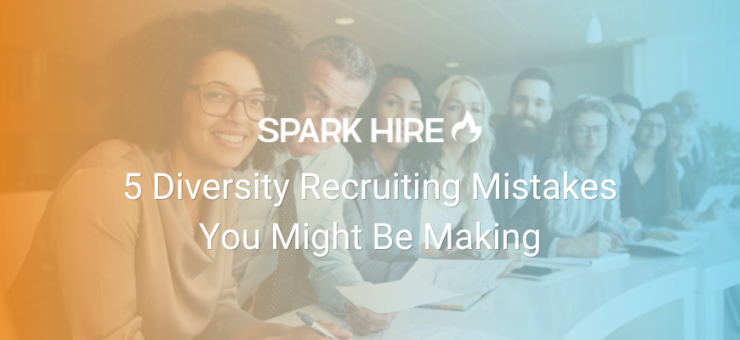Workplace diversity recruiting is a hot topic in public, private, and non-profit organizations. And yet, despite 69% of employers claiming to have a diversity, equity, and inclusion (DEI) program in action, a 2021 Just Capital survey found that 1 in 4 employees are doubtful about progress made in this area.
Indeed, professionals and activists from versatile communities have led a charge to increase diversity across all positions, and many organizations have heard their voices. However, a truly actionable DEI program starts with effective hiring strategies.
Unfortunately, there is a whole bunch of diversity recruiting mistakes you might be making without even noticing. Thus, there is nothing unexpected that your attempts to diversify your workforce might fail.
Here are some of the most common diversity recruiting mistakes that might be holding you back from attracting and hiring diverse candidates for emerging professional roles:
What is diversity recruiting?
In simple words, diversity recruiting is a talent acquisition process based on special care taken to ensure procedures have reduced biases related to a candidate’s age, race, gender, religion, sexual orientation, and other personal characteristics that are unrelated to their job performance.
Apart from actively seeking job candidates from diverse backgrounds, diversity recruiting also means removing barriers that prevent all candidates from having equal opportunities during the hiring process.
Despite the many misconceptions, the goal of diversity recruiting is not to force a quota or cut corners on skills and experience but to create an innovative workplace culture that encourages performance and unique perspectives and thoughts. In fact, a survey by Cleverpop found that inclusive teams make better business decisions up to 87% of the time at 2X the speed, with half as many meetings.
5 diversity recruiting mistakes that might be holding you back
Diversity, equity, and inclusion have become increasingly commonplace for large and small enterprises worldwide. But, quite often, even the most well-intentioned and experienced organizations and managers struggle to create a truly diverse workforce.
Research has found that the unemployment rate for Black and Hispanic populations in the United States is well above the national average. At the same time, only 8% of Fortune 500 CEOs are women.
Despite the effort made, these problems often result from mistakes hiring managers and company owners continue to make. Thus, before investing time, money, and energy into getting your initiatives off the ground, ensure you’re avoiding the common pitfalls described below.
Mistake 1: Failure to move from DEI policy to action
Unfortunately, diversity recruiting does not stop at a mere policy change. What is worse, 75% of the surveyed companies treat DEI as a compliance issue and don’t even bother to mention diversity in leadership development or the company’s overarching learning and development (L&D) strategy.
Organizational leaders must ensure DEI is a core value, not an afterthought. DEI policy implementation requires analysis of all the hiring processes and continuous efforts at every stage. Therefore, to make it actually work for your company, you need to shift from star-studded social media posts to actual accountability.
Mistake 2: Focusing only on entry-level roles
Thinking that concentration on the entry-level position can tackle all the diversity issues within the organization is another mistake you might make even without noticing it. This misses the mark of true diversity, which should apply throughout the organization at all levels.
A survey by human resources consulting firm Mercer found that while White workers make up 64% of entry-level employees, they make up 85% at the executive level. This data illustrates the barriers that BIPOC workers face when it comes to advancement.
To overcome these barriers, the principles of diversity, equity, and inclusion should be applied to all hires made by the company, no matter at what stage of DEI strategy development or implementation you are.
Mistake 3: Reliance on technical assessment
Standardized technical assessments prove to be one of the biggest culprits when it comes to bias in the hiring process. Hiring should never be based solely on one of these tests, as they prove unfair to those without access to training.
Instead, the technical assessment should be used as a guide to help recruiters and hiring managers determine a candidate’s weaknesses and strengths. However, it should not play a key role in the decision. Diversity issues start with people, and that means they need people to figure out how to solve those issues.
Mistake 4: Using CVs
Indeed, CVs have been around so long that most employers would feel utterly helpless without them. At first sight, there is nothing wrong with this practice. However, experiments across the US, Canada, and Australia found that even when applications are identical, candidates with ‘white-sounding’ names receive up to 50% and 75% in the UK more responses. Besides that, unintended systemic bias occurs when reviewing resumes that are identical apart from names that signify a gender or a signifier of LGBTQIA+ status.
Furthermore, CVs are often riddled with exaggeration. At best, they contain embellished versions of the best things applicants have ever done, cherry-picked from what is most likely an otherwise checkered employment history.
The solution for this has been to remove names or any identifiable data from an interview or CV screening, apply more advanced HR tools, and step away from using CV data to determine job suitability.
Mistake 5: Making biased offers
The job description you post when seeking a candidate is your offer. Sometimes, these offers appear more precise than we expect them to be. In other words, the bias in your job post predicts who you’ll hire because the language affects who applies to your job.
For instance, the language in your job descriptions could be deterring women from applying. The over-use of masculine language like ‘superior,’ ‘competitive,’ ‘decisive,’ and ‘determined’ proves to have a considerable effect on the gender balance of your candidate pool.
Having an inclusive company starts with creating inclusive job descriptions. Therefore, to make your effort efficient, you should work on eliminating not only masculine language but unnecessary experience and education requirements as well as racially biased phrases like “a native English speaker.”
Conclusion
Diverse recruiting doesn’t simply occur without any effort. Undoubtedly, this may seem a time-consuming and daunting task. However, working hard to eliminate hiring mistakes and putting an inclusion-minded culture in place has serious returns.
Ensuring diversity at the highest level of an organization actually starts with small steps. Keep in mind that organizations implementing meaningful diversity hiring procedures help undo decades, if not centuries, of discriminatory treatment.
 Tania Doshko is a motivated and avid content creator who believes in the power of quality writing for business success. She finds her inspiration in careful observations and amazement with the fastly developing world.
Tania Doshko is a motivated and avid content creator who believes in the power of quality writing for business success. She finds her inspiration in careful observations and amazement with the fastly developing world.











